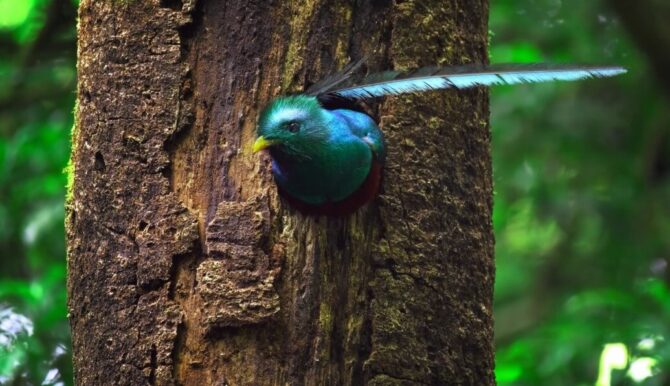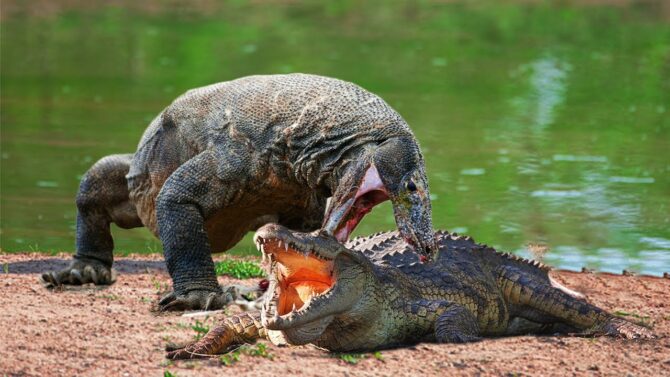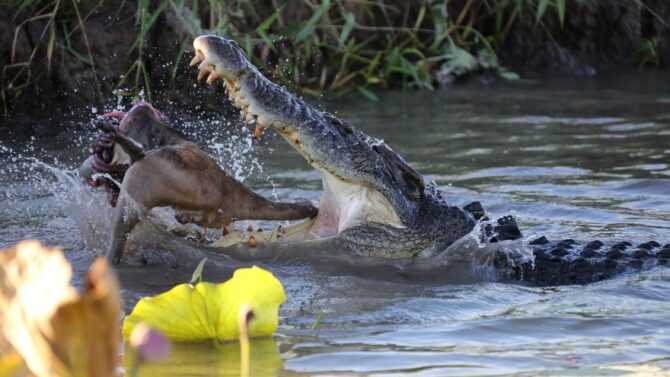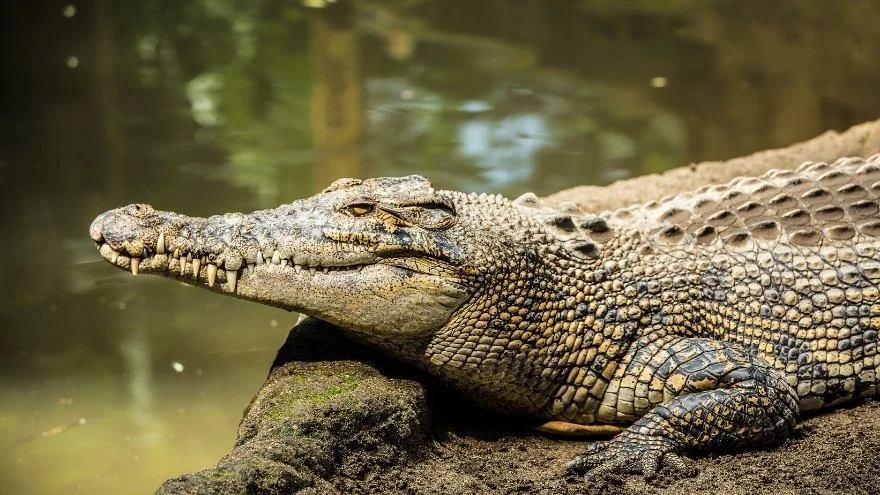The crocodile is a reptile of the family Crocodylidae and compared to others of its kind it is very large.
It lives both on land and water, making it a semi-aquatic reptile. These guys have a notorious reputation, and they are more feared than loved by people.
The crocodile is sometimes mixed up with the alligator, and sometimes people refer to them as the same.
However, just as frogs and toads differ, there’s a space between the two reptiles. Crocs are unique animals, complete with their appearance, behavior, and diet.
Scientific Classification
- Kingdom: Animalia
- Phylum: Chordata
- Class: Reptilia
- Order: Crocodilia
- Family: Crocodylidae
- Genus: Crocodylus
- Scientific Name: Crocodylus acutus
Characteristics
- Length: 5.5 to 23 ft
- Weight: 40 to 2,200 pounds
- Venom/Poison: No
- Skin Type: Scales
- Habitat: Lakes, rivers, marshes, lagoons, estuaries, and mangrove swamps
- Range: Africa, Asia, Australia, Americas
- Diet: Carnivore
- Life span: 20 to 70 years
- Sexual Maturity: 4 to 12 years
- Gestation Period: 80 to 90 days
- Conservation status: Least Concern
5 Interesting Facts About Crocodiles
1. They can have 4,000 teeth in a lifetime
The typical croc has between 60 to 110 teeth, and there’s a significant difference between them and us.
Humans only grow teeth once, and after that, if you lose a tooth you will need to either consult a dentist or live without the tooth. We only get one natural teeth chance for a change.
Crocs are different. These guys can grow a tooth to replace a lost one as much as needed. In a lifetime this could make them get up to 4,000 teeth, and some sources even say 8,000.
2. They have the strongest bite force
The crocodile’s bite force is often measured at 3,700 PSI or 16,460 newtons. To show you how strong it is, it takes about 4,000 newtons to break a human’s femur, which is the strongest bone in the body. Imagine getting more than 16,000 newtons!
This reptile’s bite is heralded as the strongest in the world, and it far surpasses other predators.
The tiger has a bite force of 1,050 PSI, the lion is a meager 650 PSI, and the hippopotamus measures up to 1800 PSI, among others.
The great white shark is the only animal that could rub shoulders with the croc, but the former’s bite force (4,000 PSI/ 18,000 N) remains an estimate.
3. There’s a reason for the expression ‘crocodile tears’
There’s a belief that these reptiles shed tears when devouring their prey, leading to the expression ‘crocodile tears’ used to denounce someone who may be faking tears. There’s a bit of truth in this claim, but it’s not the whole story.
Crocodiles have tear glands, but while eating prey they are not shedding tears the way we would define it. They do not cry out of any false sense of remorse, but for more biological reasons.
4. They eat without chewing
Another food fact about this creature is that it eats without chewing. Their jaw is shaped in such a way that it can’t move sideways, so they can’t chew the way humans and some other animals would.
Their jaw muscles are also sensitive, which could contribute to not being able to chew.
They ensure their meal gets digested by swallowing stones. These stones help break down the meal.
5. Crocodiles and humans are enemies
Although humans are at the top of the food chain, crocs do not hesitate to attack when needed. Unlike some other animals that may mind their business till they’re provoked, the reptiles will go after you unprovoked.
Their attack is considered more dangerous than that of a shark, and they can cause damage on a large scale.
A good example is the World War 2 saga known as the Battle of Ramree. Though there have been some doubts as to how large the incident was, crocodiles were responsible.
General Description
Crocodiles are ancient animals, and little has changed since 200 million years. They existed alongside dinosaurs, and both reptiles were classified in the same group Archosaurs. This means they survived the asteroid that led to dinosaurs getting extinct.
There are 13 species in existence today, living in both fresh and salt waters. They are popular reptiles, and their rank as apex predators leaves them with fewer enemies other than humans. Relatives include the alligator, caimans, and gharials.
A typical individual has a strong body filled with scales, a powerful jaw, and speed, especially in water. They tire out quickly on land but are still fast enough to trap prey.
The body has armored plates that serve both as protection and to keep the skin from drying out. Crocodiles are experts at camouflage, and their colors serve well.
These colors include black, brown, green, grey, and olive. Camouflage is a good tool for hunting, and these creatures make good use of it.
Distribution and Habitat
Crocodiles can be found in every continent except Antarctica. They’re located in Africa, Australia, Asia, and the Americas (North, Central, and South).
Some species are more prominent in an area than others. For instance, the Nile Crocodile is native to Africa while the American croc is very common in the Americas.
The crocodile’s favorite spots are usually wetlands, and sunlight is important for these reptiles. They are cold-blooded animals, meaning they cannot regulate body temperature.
It’s not uncommon to find them warming under the sun, much like lizards and snakes. Overall, they inhabit lakes, marshes, lagoons, rivers, and mangrove swamps.
Diet
As apex predators, crocodiles are carnivores. Some are known to eat fruits, but not enough to be classified as an omnivore. They’re top of the food chain in their natural environments and have solid hunting skills.
They combine camouflage and strong jaws to grab prey. Because they can’t chew, they use ambush a lot to swallow the game.
The adults can hunt down big animals, and their diet includes deer, water buffalos, and even zebras. Younger ones can’t go after big prey, so their diet consists of crustaceans, small mammals, fish, birds, and reptiles.
Hunting is done a lot at night, and anyone moving in an area with crocodiles during that time may face the risk of an attack. During the nighttime, they are more likely to move on land in search of prey.
Some species hunt alone, while others team up. The Nile crocodile is an example of the latter category. It primarily hunts down fish, especially catfish.
One special trait this animal has is the ability to stay for years without eating. They can slow their metabolism to the point of looking dead, and then live off their tissues.
Reproduction and Mating Process
Crocodiles reproduce sexually, with the male and female coming together to mate. January and February are when courtship happens, and the male often initiates the process.
Courtship and reproduction are considered more complex than other reptiles.
Breeding depends on the species and the location. Freshwater individuals tend to breed during the dry season while their saltwater counterparts opt for the wet ones. Those in captivity have a slightly different routine.
Courtship first begins with the males first establishing themselves in a territory. This might involve fighting if two males locate a particular spot they want.
This fight is rare, though. In common cases, once a male establishes dominance over territory, he goes unopposed.
The next step is to attract the female. The male approaches his potential mate and rubs his head to hers gently. This could be the crocodile’s version of “want to go out sometime?”
If the female is interested, she will raise her body to encourage the male. If she isn’t, she swims away. When there’s positive feedback, the male proceeds to the third step by mounting the female.
After mating is done, the female takes on the reproduction wheels by laying eggs. The number of eggs laid depends on the species, and they can go from 17 to 100. Females build a nest in which they lay their eggs, and they’re known to be highly protective of this nest.
Incubation goes on for about 3 months, after which the eggs hatch into little crocs. The mother transports these small ones to water using a pouch in the mouth.
Predators and Threats
Being apex predators, crocodiles have very few threats. This is especially the case for adults of big species.
The only animals that may threaten this reptile are big cats like lions, tigers, and jaguars. This happens occasionally, however, and the crocodile isn’t a common prey of these cats.
Younger ones (especially smaller species) may find themselves getting attacked by animals like dogs and wild pigs. Eagles can also prey on these smaller individuals.
Humans are croc’s biggest threats. They get threatened by our hunting activities, loss of habitat, and pollution of the environment.
Behavior
Crocs are social, though the level depends on the species in question. They’re usually nocturnal, and only come out in the daylight to get the sun on their skin.
Cold-blooded animals, need sunlight to regulate temperature. Some smaller species are arboreal, an example of which is dwarf crocodiles. These can climb on branches to bask in the sunlight.
The social group is usually mixed with both adults and young ones. The only problem they might have is during mating season when the males become territorial. Other than that, individuals get along well.
As we noted above, the relationship between humans and these reptiles is conflicted. They can attack and kill humans, while we in turn threaten their existence. There are also many of them in captivity, thanks to humans.
The annual death rate of people caused by crocodiles has reduced, but not eliminated. On the side of the reptiles, while some species are safe, others have their population declining steadily.
A good example is a Philippine crocodile. With an estimate of only 200, the aforementioned species is set for extinction.
Male vs Female
It is hard to tell the difference between a male and a female crocodile as they both have a lot in common. Simply relying on sight won’t achieve much.
Only through careful observation can someone distinguish the sexes. Of course, if you come across a croc in the wild, trying to determine the sex shouldn’t be your first concern.
There are differences, though, one of which is size. The male is usually bigger than the female, so a very large individual could be a male. However, the gap isn’t wide. Size isn’t always the best indicator of gender.
The only certain way to know is to check the genitals. Like many animals, males have a penis while females come with a clitoris.
Frequently Asked Questions
Is an alligator a crocodile?
Alligators look like crocodiles and are sometimes lumped into the same category. However, they aren’t the same. There are a couple of differences between both reptiles, one of which is size. The crocodile is the bigger one of the duo.
Can I own a crocodile as a pet?
Crocodiles may be kept in captivity and at zoos, but they do not make good pets. They can’t be tamed, don’t bond with humans, and are best left in the wild. Do not try to own one if you’re not an experienced handler. You can go for tamer reptiles instead.
Are crocodiles dinosaurs?
When dinosaurs were around, they were classified in the same group as crocodiles. However, the latter is vastly different from the former.
What are the characteristics of a crocodile?
These reptiles are known for their scaly skin, dull colors, and long bodies. They also have strong jaws and a bite force that can rip a human limb for limb. Crocodiles are dangerous apex predators and should not be messed with.
Conclusion
The crocodile is a wild reptile of the family Crocodylidae, and for all its notoriety it is still important and should be preserved.
Fortunately, many species are still thriving. This is sadly not the case for a few that are dwindling in number, and thankfully there are efforts to conserve them.
If you ever come across this reptile, try not to get its attention towards you. It may not need a reason to go after you, and it’s best to prevent the altercation from happening to begin with.
You can also avoid any of their habitats. If it does attack, there are steps to survive a crocodile attack.





![Do Crocodiles Have Tongues & Taste Buds [Answered]](https://animalvivid.com/wp-content/uploads/2022/10/Do-Crocodiles-Have-Tongues-Taste-Buds-Answered.jpg.webp)

